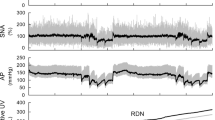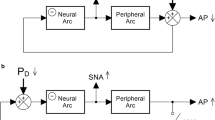Abstract
This paper presents a physiological long-term model of the cardiovascular system. It integrates the previous models developed by Guyton, Uttamsingh and Coleman. Additionally it introduces mechanisms of direct effects of the renal sympathetic nerve activity (rsna) on tubular sodium reabsorption and renin secretion in accordance with experimental data from literature. The resulting mathematical model constitutes the first long-term model of the cardiovascular system accounting for the effects of rsna on kidney functions in such detail. The objective of developing such a model is to observe the consequences of long-term rsna increase and impairment of rsna inhibition under volume loading. This model provides an understanding of the rsna-related mechanisms, which cause mean arterial pressure increase in hypertension and total sodium amount increase (sodium retention) in congestive heart failure, nephrotic syndrome and cirrhosis.
Similar content being viewed by others
References
Barba, G., F. P. Cappuccio, L. Russo, F. Stinga, R. Iacone, and P. Strazzullo. Renal function and blood pressure response to dietary salt restriction in normotensive men. Hypertension 27:1160–1164, 1996.
Barrett, C. J., R. Ramchandra, S.-J. Guild, A. Lala, D. M. Budgett, and S. C. Malpas. What sets the long-term level of renal sympathetic nerve activity, A role for angiotensin II and baroreflexes. Circ Res. 92:1330–1336, 2003.
Bigelow, J. H., J. C. Dehaven, and M. L. Shapley. System analysis of the renal function. J. Theor. Biol. 41:287–322, 1973.
Braith R. W., R. M. Mills, C. S. Wilcox, V. A. Convertino, G. L. Davis, M. C. Limacher, and C. E. Wood. Fluid homeostasis after heart transplantation: The role of cardiac denervation. J. Heart Lung Transplant. 15:872–880, 1996.
Braith R. W., R. M. Mills, C. S. Wilcox, G. L. Davis, and C. E. Wood. Breakdown of blood pressure and body fluid homeostasis in heart transplant recipients. J. Am. Coll. Cardiol. 27:375–383, 1996.
Cameron, W. H. A model framework for computer simulation of overall renal function. J. Theor. Biol. 66:551–572, 1977.
Coleman, T. G., and J. E. Hall. A mathematical model of renal hemodynamics and excretory function. In: Structuring Biological Systems: A Computer Modelling Approach, edited by S. S. Iyengar. Boca Raton, Florida: CRC Press, 1992, pp. 89–124.
Denton, K. M., A. Shweta, and W. P. Anderson. Pregulomerular and postglomerular resistance responses to different levels of sympathetic activation by hypoxia. J. Am. Soc. Nephrol. 13:27–34, 2002.
DiBona, G, F., S. Y. Jones, and L. L. Sawin. Effect of endogenous angiotensin II on renal nerve activity and its arterial baroreflex regulation. Am. J. Physiol. 271 (Regul. Integr. Comp. Physiol. 40):R361–R367, 1996.
DiBona, G. F., and L. L. Sawin. Reflex Regulation of Renal Nerve Activity in Cardiac Failure. Am. J. Phsiol. 266 (Regul. Integr. Comp. Physiol. 35):R27–R39, 1994.
DiBona, G. F., S. Y. Jones, and L. L. Sawin. Angiotensin receptor antagonist improves cardiac reflex control of renal sodium handling in heart failure. Am. J. Physiol. 274 (Heart Circ. Physiol. 43):H636–H641, 1998.
DiBona, G. F., and U. C. Kopp. Neural control of renal function. Physiol. Rev. 77(1):75–197, 1997.
DiBona, G. F., L. L. Sawin, S. Y. Jones. Characteristics of renal sympathetic nerve activity in sodium retaining disorders. Am. J. Physiol. 271 (Regul. Integr. Comp. Physiol. 40):R295–R302, 1996.
DiBona, G. F., L. L. Sawin. Role of renal nerves in sodium retention of cirrhosis and congestive heart failure. Am. J. Physiol. 260 (Regul. Integr. Comp. Physiol. 29):R298–R305, 1991.
DiDona, G. F. Neural control of the kidney: Past, present and future. Hypertension 41(part 2):621–624, 2003.
Feng, J. H., N. D. Markondu, and G. A. McGregor. Importance of the renin system for determining blood pressure fall with acute salt restriction in hypertensive and normotensive whites. Hypertension 38:321–325, 2001.
Greenberg, S. G., S. Tershner, and J. L. Osborn. Neurogenic regulation of rate of achieving sodium balance after increasing sodium intake. Am. J. Physiol. 261:F300–F307, 1991.
Guyton A. C., A. E. Taylor, and H. J. Granger. Circulatory Physiology II: Dynamics and Control of the Body Fluids. Philadelphia:W. B. Saunders Company, 1975, p. 252, 287.
Guyton, A. C., and J. E. Hall. Textbook of Medical Physiology. Philadelphia: W. B. Saunders Company, 2000, p. 202, 309.
Guyton, A. C., and T. G. Coleman. Long-term regulation of the circulation: Interrelationships with body fluids volumes. In: Physical Bases of Circulatory Transport: Regulation and Exchange, edited by E. B. Reeve and A. C. Guyton. Philadelphia: W. B. Saunders Company, 1967, pp. 179–201.
Guyton, A. C. Circulatory Physiology III: Arterial Pressure and Hypertension. Philadelphia: W. B. Saunders Company, 1980, p. 169, 172, 198, 199, 200, 201.
Guyton, A. C., T. G. Coleman, and H. J. Granger. Circulation: Overall regulation. Ann. Rev. Physiol. 34:13–46, 1972.
Guyton, A. C. Determination of cardiac output by equating venous return curves with cardiac response curves. Physiol. Rev. 35:123–129, 1955.
Hall, J. E., M. W. Brands. The renin angiotensin-aldosterone systems: Renal mechanisms and circulatory homeostasis. In: The Kidney, Physiology and Pathophysiology, edited by D. W. Seldin and G. Gebisch. Philadelphia: Lippincott Williams & Wilkins, 2000, p. 1038.
Huang W. C., and J. N. Wu. Blunted renal responses to atrial natriuretic peptide and its reversal by unclipping in one-kidney, one clip goldblatt hypertensive rats. J. Hypertens. 15(2):181–189, 1997.
Ichikawa I. Hemodynamic influence of altered distal salt delivery on glomerular microcirculation. Kidney Int. 22(Suppl 12):S109–S113, 1982.
Ikeda N., F. Maruo, M. Shirataka, and T. Sato. A model of overall regulation of body fluids. Ann. Biomed. Eng. 7:135–166, 1979.
Jacob, F., P. Ariza, and J. W. Osborn. Renal denervation chronically lowers arterial pressure independent of dietary sodium intake in normal rats. Am. J. Physiol. Heart Circ. Physiol. 284:H2302–H2310, 2003.
Kottke, F. J., W. G. Kubicek, and M. B. Visscher. The production of arterial hypertension by chronic renal-nerve stimulation. Am. J. Physiol. 145:38–47, 1945.
Krück, F., and H. J. Kramer. Third factor and edema formation. Cont. Nephrol. 13:12–20, 1978.
Lohmeier, T. E. Interactions between angiotensin II and baroreflexes in long-term regulation of renal sympathetic nerve activity. Circ. Res. 92:1282–1284, 2003.
Lohmeier, T. E., D. A. Hildebrandt, and W. A. Hood. Renal nerves promote sodium excretion during long-term increases in salt intake. Hypertension 33(part II):487–492, 1999.
Lohmeier, T. E., H. L. Mizelle, G. A. Reinhart, and J. P. Montani. Influence of angiotensin on the early progression of heart failure. Am. J. Physiol. Regul. Integr. Comp. Physiol. 278:R74–R86, 2000.
Mejia R., J. F. Sands, J. L. Stephenson, and M. A. Knepper. Renal actions of atrial natriuretic factor: A mathematical modeling study. Am. J. Physiol. 257 (Renal Fluid Electrolyte Physiol.) 26:F1146–F1157, 1989.
Miki K., Y. Hayashida, and K. Shiraki. Cardiac-renal neural reflex plays a major role in natriuresis by left atrial distention. Am. J. Physiol. 264 (Regul. Integr. Comp. Physiol. 33):R369–R375, 1993.
Nelson, L. D., and J. L. Osborn. Neurogenic control of renal function in response to graded nonhypotensive hemorrhage in conscious dogs. Am. J. Physiol. 264 (Regul. Integr. Comp. Physiol. 33):R661–R1667, 1993.
Nomora, G., T. Takabatake, S. Arai, D. Uno, M. Shimao, and N. Hattori. Effect of acute unilateral renal denervation on tubular sodium reabsorption in the dog. Am. J. Physiol. 232(1):F16–F19, 1977.
Reinhart, G. A., T. E. Lohmeier, and C. E. Hord. Hypertension induced by chronic renal adrenergic stimulation is angiotensin dependent. Hypertension. 25:940–949, 1995.
Singer, D. R. J., N. D. Markandu, J. J. Morton, M. A. Miller, G. A. Sagnella, and G. A. MacGregor. Angiotensin II suppression is a major factor permitting excretion of an acute sodium load in humans. Am. J. Physiol. 266 (Renal Fluid Electrolyte Physiol 35):F89–F93, 1994.
Uttamsingh, R. J., M. S. Leaning, J. A. Bushman, E. R. Carson, and L. Finkelstein. Mathematical model of the human renal system. Med. Biol. Eng. Comput. 23:525–535, 1985.
Author information
Authors and Affiliations
Corresponding author
Rights and permissions
About this article
Cite this article
Karaaslan, F., Denizhan, Y., Kayserilioglu, A. et al. Long-Term Mathematical Model Involving Renal Sympathetic Nerve Activity, Arterial Pressure, and Sodium Excretion. Ann Biomed Eng 33, 1607–1630 (2005). https://doi.org/10.1007/s10439-005-5976-4
Received:
Accepted:
Issue Date:
DOI: https://doi.org/10.1007/s10439-005-5976-4




